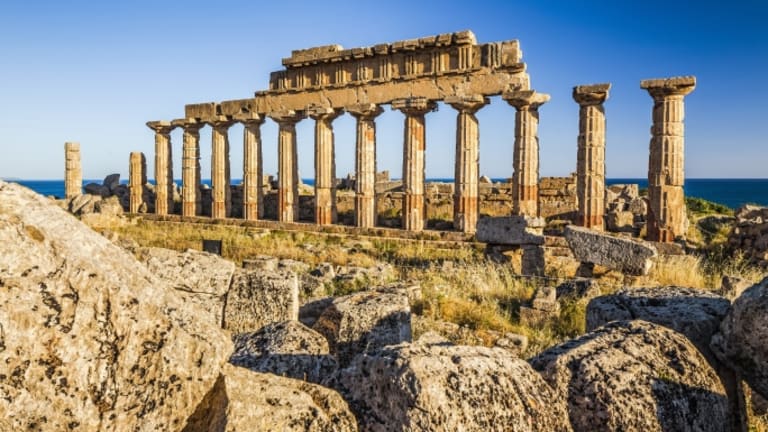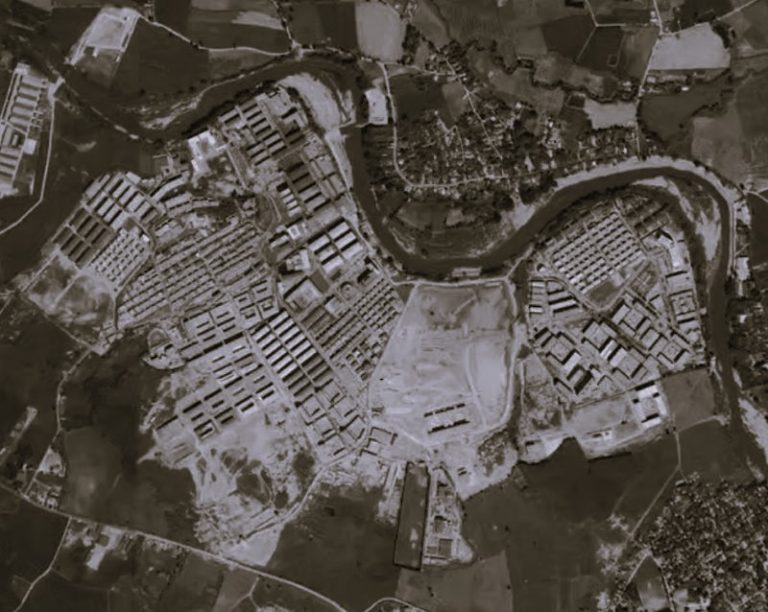

Following training and cooperation with the Phoenicians, the ancient Greeks launched a huge wave of colonization across the Mediterranean.

By Dr. Polyxeni Adam-Veleni
Director
Archaeological Museum of Thessaloniki
The borderline from the 8th to the 7th century BC marked by three very important events which determined the course of Western civilization and greatly affect our lives today. The first was the invention of the Greek alphabet, the first phonetic alphabet in Europe where then came the Latin alphabet and the rest of European countries. The Greek alphabet emerged by adding vowels according to the Phoenician alphabet. The Greeks had close relations with the Phoenicians as early as the 12th century and taught them the art of navigation in the Mediterranean.Phoenicians and Greeks: two seafaring peoples who left their marks on the Mediterranean routes. Their presence affected the fate of many other peoples and opened roads of trade and culture. The Phoenicians, with an older seafaring tradition, were the pioneers. They tamed the sea and taught the Greeks the way to master it. Soon, the Greeks became their main antagonistics in their maritime enterprises. They use this knowledge for several centuries to create a huge wave of colonization, much larger and ambitious than what we had tried their incomplete knowledge in the 12th century BC.
The third important achievement was the invention of trading not with exchanging products but buying goods with precious metals. First with iron spits at the end of the 8th century and immediately after the first coins, so it became much easier the transactions. The forerunners of the coinage were the iron obeloi found at the Heraion of Argos. Their established use as a coin attributed to Pheidon King of Argos probably dates from the end of the 8th century. In the middle of the 7th century, or just after the first coins from electro, a special alloy of silver and gold were struck in Ionia at Lydia. Without doubt the subsequent development of coinage is due to that admirable capacity of the ancient Greek spirit.

View from the Heraion of Argos into the Inachos plain / Photo by Sarah Murray, Wikimedia Commons
The Greeks at the end of the 8th century and early 7th have three very strong “weapons” to expand their territory. Common Greek alphabet with which they can have better communication between them, coinage which are easier for the transactions and good knowledge of navigation. The narrow limits of the continental body, the Aegean and Ionian islands and the coast of Asia Minor is not enough for them: in the next two centuries, they will seek new fertile lands and new productive resources. The adventure of the second period of Greek colonization starts. Creating a colony of a city state was not simple matter. Most often this expedition had been preceded by several trips to find a suitable place and to reach to the proper conditions to create a colony. When it was to find a colony was never in a hurry. Usually they calculated everything down to the smallest detail. In which place, what region in Mediterranean coast, close to whom and what commercial benefits would have been, were their basic notions. Could they easily sell their products? Were local products that could trade them in their motherland? Existed available land for cultivation? And if so, could cultivate it without any local conflicts? These were fundamental questions that concerned them for long before deciding the establishment of the colony. But let us better see the procedure for founding a colony.
It is indisputable that the foundation of a colony was a momentous event for acity-state in Mainland or Island Greece. Usually, it was the natural outcome of previous exploratory voyages in search of wealth-generating resources or the result of trading transactions between the mother-city (metropolis) and a distant land. The reasons for founding a colony varied: political, economic, social, demographic and so on. The phenomenon of founding colonies became more widespread and systematic during the 8th century BC, when the Greeks succeeded in building better ships, capable of navigating in remote and inhospitable seas. Concurrently, the close contact between Greeks and Phoenicians and the growing competitiveness between the two seafaring peoples began to create the preconditions, and frequently the necessity, for more permanent residence in afar-off place. With their ships, the Greeks succeeded in taming the fiercest seas,anchoring in sheltered harbours at the outposts of the Mediterranean Sea, the Euxine Pontos and the African coasts, and creating new cities, many of which continued in existence for over three thousand years and are still lively today.In most cases the foundation of a colony was prepared in advance, by establishing small installations or by operating local trading posts (emporia) in the territory earmarked for colonisation, several years before the final settling there of a population from the metropolis. However, the ties of a city state with its colony did not cease with its foundation. The metropolis continued to show interest in the colony and to exercise influence on it. Thus, the successful foundation of the city-colony was of multiple significance for the metropolis, which usually took care to maintain its political, economic and social ties with the newly founded daughter city. Information on the foundation of cities-colonies is drawn from the textual sources. However, these do not record sufficient details on theway in which the colonisation took place. Undoubtedly, this would be determined each time by different parameters related to the administrative organisation,the importance and the economic prosperity of the metropolis, as well as the conditions characteristic of the new land. Practical matters had to be solved,ranging from how the site for colonisation and the group of pioneer colonists would be chosen to how the public and private buildings in the new city would be constructed. It was the metropolis that had a supportive function with regard to economic, demographic and administrative issues, which is the reason why it sought, even if the colony it founded became powerful after some time, to have a say in its domestic affairs, so as to reap benefits from its colony’s prosperity.The appointed leader of the colonising mission, who was also considered founder of the city, was the oikistes.
The oikistai were eminent figures in the society of a metropolis. Many cities honoured in perpetuity their oikistai, erecting hero or imposing tomb monuments and worshipping them with offerings and religious rites. The metropolis ceded to the oikistes absolute authority; he was autokrator, which meant that everyone who participated in the creation of a colonial city was obliged to obey his orders without objection. The ceding of this absolute authority to one person,the oikistes, seems quite reasonable, given that the host of people the metropolis decided to send to colonise a place was often motley, sometimes even coming from different city-states. Thus, only as autokrator could the oikistes cope with all the difficulties and issues that arose in the course of the venture. Other colonists,always men, were appointed to support the principal oikistes, as well as specialists who contributed to the laying out and the initial organisation of the colony. Although the sources are rather vague on the matter, it seems logical to assume that this group was dispatched as an advance reconnaissance party, preceding the rest of the potential inhabitants of a colony, in order to seek out the place, locate the most promising site and organise the life of the colony. The population of women, children and more elderly persons followed. The view that only men were involved in the colonisation and that they then married women from the local population does not seem to apply, except for some cases, as the sources preserve testimonies of priestesses who were moved to the colony after its foundation or of women who sped to be reunited with their husbands, together with the rest of the family, as soon as the settlement process had been completed.

Vlasto Oikistes Nomos / Creative Commons
The principal oikistes and the other colonists were accompanied by geonomoi, who played a decisive role in selecting the site for building the city and in allocating the land, as the successful foundation of the city depended primarily on its correct and precise measurement. Consequently, the foundation of the colony was related directly to the measurement and the distribution of land. After the main task of mapping the area where the various buildings of the colony were to be constructed, the architects played a significant role, defining the spaces intended for the public edifices, the necropoleis and the sanctuaries, and then designing the civic complexes and the private residences. With regard to the spatial planning of the sanctuaries, special attention was paid to delimiting the lots of agricultural land in their vicinity, from the leasing of which the expenses of the upkeep of the temenos were covered. Thus, if the oikistes was responsible for selecting the site, the geonomoi were responsible for measuring the land and allotting it justly to the colonists and the architects were entrusted with the spatial planning of the city’s functions and the design of its public and private buildings.In some cities, where this process was not followed and no architects were employed, as for example in Akragas, problems, which are noted in some of the sources, arose in their orderly functioning. The simplest method of dividing up the land was into parallel zones, which, in their turn, could be easily allocated in smaller parts. Plots of equal size were the lots both in the cities and the rural territories, while, as one may assume from their name in the sources, kleroiormeri, the parcels of land were distributed by drawing lots (klerose). The question whether the distribution of lots was made on the basis of the principle of equal share preoccupied at various times philosophers, such as Plato and, primarily,Aristotle. Despite doubts expressed at times on the fairness of this system of dividing and distributing the ground, the parcelling of the land into parallel zones, which ranged in size from 4 to 10 hectares, depending on the configuration of the terrain, was kept throughout antiquity.
The place of settlement was usually coastal and at low altitude. The colonists preferred to design the new cities-colonies on peninsulas, even if the ground space was limited. More rarely, they chose sites further inshore, in sheltered bays, or on plains in the hinterland, always on condition that there was easy and direct access to the coast. Proximity to the sea was the first and essential prerequisite,as in most cases, this was the main reason for founding each colony.If the ground at the chosen point was also slightly elevated, this was undoubtedly an important advantage, but it was not the decisive parameter for selecting the site. Otherwise, the city-colony was laid out on completely flat ground. The choice of laying out on flat ground and not on steep or high slopes was also amain difference from the sites that had been chosen for the metropoleis in Geometric and Archaic Times. The size of the colonial cities varied and usually exceeded that of their metropoleis, which in the meantime had already expanded.An average-size colony covered about 80 hectares but there were also larger cities of up to 200 hectares. In this mean area, some 4,000 to 5,000 houses could be arranged, which corresponded to an average population ranging from 30,000 to 50,000 inhabitants. Of course, during their early years, the colonies had small populations of 200 to 1,000 persons and their demographic increase was gradual. The primary concern of each oikistes was to set the boundaries of the city by raising a strong fortification before anything else. The city walls followed the lie of the land and their construction was adapted accordingly. Intramuros, all the colonies were planned in parallel zones, between which building insulae were created. The width of the parallel zones varied from 29 to 35 metres. Depending on the availability of space, the zones ran in the same or in a different direction. Frequently, as in the case of Selinous for instance, the direction of these zones was determined by two hills. The vertical streets, which defined the length of the building insulae, were usually arranged at fixed intervalsso that the insulae were of the same size. However, the scheme followed in each case was different, because it was dependent on the space available each time.In accordance with the standards of the city-state, as these were first formulated in the Archaic Period and evolved in the Classical Period, the new city founded as a colony ought to have administrative autarky in the land in which it was established. Despite the fact that the concept of the city state must have existed from Classical Times onward, its urban model of function was formulated much earlier. Thus, for the orderly functioning of a city-state, a series of constant parameters was imposed: living space enclosed by fortification walls, laying out of a regular urban plan, temples and temene for the practice of worship, agora, theatre, gymnasium and private houses, sufficient area for cemeteries and land for cultivation (chora).
In the colonies, as in the metropoleis, the spatial planning of the public functions of each city was of decisive significance. The nucleus of public life was the agora, where the official buildings of the administration stood, such as the prytaneion, the bouleuterion, some urban sanctuaries, public fountains and exedrae, the theatre and whatever else concerned the urban daily life of the citizens. Theshops, private or public, depending on the merchandise, were also there or close by. The agora was usually situated in a position that ensured direct access to the harbour installations, for easier loading and unloading of cargoes. Sometimes the workshops producing various goods were arranged on the fringe of the agoraor directly outside its walls and close to the seaward accesses. In some cities,such as Metapontion, which spread between two rivers and had abundant fertile land for cultivation, between the city and the fields, where scattered farm-steads were located, there was an intervening zone extra muros, 1,300 metres wide that was intended for the gardens and the necropolis. The agora was usually surrounded by a system of horizontal and vertical street axes that also defined the building insulae with the private houses around it. Sometimes, a wide central street passed through its main axis. The earliest example of an organised agora of a colony is that at Megara Hyblaia in the second half of the 7th century BC,where the agora occupies a triangular space between streets running in different directions. In other cases, such as Akragas, which seems to have been one of the few cities planned without the input of an architect, the agora was simply an open space adjacent to the city walls. The houses ranged in size from 156 to 256 square metres. They were usually provided with a rectangular pastas (chamber)and an open internal courtyard, while one part of them was two-storied to accommodate the quarters for the women and children. As the houses underwent many alterations over the years, it is difficult to discern their plan at the time of the colony’s foundation or whether they were initially single-space dwellings,as were the early houses at Megara Hyblaia in the 7th century BC, which imitated in size and plan the known houses in the metropoleis of the same period.Later, the inhabitants of Megara Hyblaia enlarged their houses and, with the addition of collateral buildings, created a kind of internal courtyard. Due to the successive changes in family properties, which in the following generations may have involved the sharing of the same plot among siblings, it is difficult to determine exactly the way in which plots were divided. In most cases, the plots were protected on the street side by high yard walls. Usually the colonists preferred to build rooms in the north part of the plot and, in front of these, they constructed a semi-outdoor space (portico) or a half-roofed chamber (pastas),serving the needs of household chores, raising children and everyday living,which offered protection from the heat and the sun in the summer and was warmer in the winter. The creation of so many new settlements-colonies in various parts of the Mediterranean basin and the Black Sea (the Euxine Pontos) surely contributed the most to defining the parameters, systematising the methods,codifying the needs and programming conscientiously all the prerequisites for the ideally correct organisation of a settlement. It could be argued that the fact that the Greeks “were forced” to build all these hundreds of new “urban”centres, under different conditions each time, enriched their thinking about the needs of a city, was linked directly with the philosophical principles and theories of their time and led them to even more “scientific” applications and implementations of their urban planning and architectural designs. In other words,with the foundation of so many urban settlements everywhere, the know-how of urban planning and construction of the period developed to a remarkable degree. It is not at all improbable that the famous “Hippodamean” system is owed to this accumulative evolutionary experience: devised by the great architect from Miletos, Hippodamus, this was considered as expressing, in the most realistic and applied manner, the basic principles of democracy.

As has been done, I hope, obviously, the creation of a colony in any part of the Mediterranean was a major factor in the development of the region. On the one hand, the local residents could sell their products and their productions, on the other, the colonists brought new consumer goods to the places that established the colonies. The acceptance of the establishment of a colony was not always peaceful. Several are the situations that the local residents have seen hostile to the presence of the colonists. However, even then, in the competition created,benefits have emerged. Most of the times, however, colonists saw the benefits of having a colony in their neighbourhood. After all, the settlers did not kill the locals to prevail. Instead, they were trying through diplomatic, negotiation and spiritual processes to disseminate the achievements of Greek civilization and to integrate within the newly established city those of the locals who wanted to join. Every city, apart from its walls, had a market where democratic decisions were taken all the decisions about the administration and all the commercial transactions took place. An essential component of everyday public life was the theatre, which was the most frequent place to gather for entertainment as well as for entertainment with the ancient Greek meaning i.e. for the education and the treatment of the soul. The Greek colonies in the Mediterranean do not know if they can easily be counted. Surely, they reach a much larger number than the one that has been identified and excavated to date. With a rough estimate far exceeds the number of 500 across the Mediterranean basin, but also on the Black Sea coast. Many of them are living settlements and cities to this day. These colonies were also the first bodies of culture and development across Europe.Through them, the habit of trading in currencies, traveling ideas, scientific and artistic achievements, and all sorts of goods from one end of Europe to the other spread. They have formed the foundation stone and model for basic principles of organization of cities and of democracy-based regimes for most of the later states of the Old Continent.
With this in 2014 at the Archaeological Museum of Thessaloniki we organized with the sponsorship of Alpha Bank, which also has one of the largest and most valued collections of coins in the world.
The exhibition “The Europe of Greece: Colonies and coins from the Alpha Bank Collection” focused on Greek colonies of antiquity that are not located in Greek territory but today belong to modern European states. The principal criterion for choosing the colonies presented were the coins of the Alpha Bank Numismatic Collection. In addition, and in order to give a fuller picture of certain representative colonies from countries of Southern Europe and the Black Sea, a small number of finds that largely define the identity of the colony was selected. At many of these ancient sites, there is continuity of life to this day, a further factor that defined the final choice. In some modern settlements or cities, influences or remains of the once flourishing Greek colony are still apparent in various aspects of their public and private life.
Beyond the objects exhibits the exhibition and the accompanying catalogue aim to include in a panoramic overview almost all the Greek colonies in the Mediterranean and the Black Seas, through maps and abundant educational material kindly provided by the excavators / authors of the texts and the entries. In this way, the huge dispersion (diaspora) of Greeks to the ends of the then-known world becomes immediately apparent. The exhibition was constructed in two units in each gallery. The introductory unit in the first gallery outlines the role of the sea as vital force of Hellenic civilisation, the main myths, the epics and the emblematic heroes invented of basis of maritime adventures. The first unit in the same gallery, entitled “Colonisation: Adventure and Challenge. Identity and Nostos”, spotlights various facets of the phenomenon of colonisation, the historical, social and economic framework that secured the suitable conditions and, primarily, its correlation with the emergence of the city-state.
In the second gallery, the unit “New Homelands from the Euxine Pontos to the Pillars of Heracles” deals with the geographical spread of the colonisation phenomenon from south Italy, Southern France, Spain, the Illyrian Coasts and the Euxine Pontos. Thirty-nine colonies are presented, the most representative of the regions. Each colony is a separate microcosm and its own particular characteristics and coinage are determined. Special weight is attached to the Greek alphabet and its dissemination, the adoption of new crops, the unification through coinage, the prevailing of Greek habits in daily life, such as the symposium,the cults and the theatre.
From Europe and the Mediterranean: Talking, Learning, Working, and Living Together 4:2 (2017 11-20), published by Europa Bottom-Up (SSOAR Open Access Repository) under the terms of a Creative Commons Attribution – Non-commercial – No Derivative Works 3.0 Germany license.






